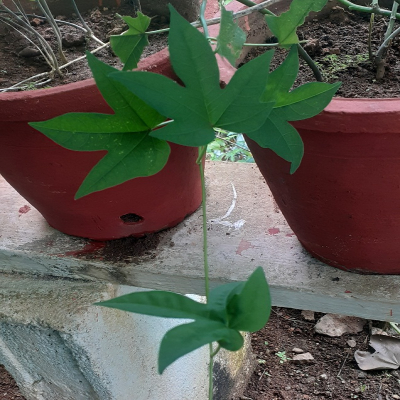Ipomoea mauritiana Jacq.
Synonyms : Ipomoea paniculata R.Br.
Family : Convolvulaceae
Group : Galactogogue, Rejuvenatives
Parts Used : Leaf , Flower , Tuber
Vernacular Names :-
| English | : | Giant potato |
| Malayalam | : | Palmuthukku |
| Hindi | : | Bilai-kand |
| Sanskrit | : | Kirividari |
| Kannada | : | Nadakumbala |
| Tamil | : | Palmudamagi |
| Telungu | : | Nelagummudu. |
Distribution and Habitat: Seen throughout tropical India in moist regions. It has been recorded in West Africa as well as Australia's Northern Territory. It is naturalised in many parts of the world including Taiwan and Hawaii. In Bangladesh, it is considered as an endangered species.
Botany: A much branched perennial evergreen climber with large ovoid tuberous root and glabrous long, thick, twining stems.
- Root: A simple or branched tuber sometimes as much as 20 kg in weight. Externally it is of brown colour and somewhat warty and scabrous.
- Leaves: 10-15 cm long, often broader than length, deeply palmately divided, 5-7 lobed, ovate-lanceolate, entire, pale, glabrous, acute or acuminate, nerves prominent beneath. Stems are about 1 cm in diameter.
- Flowers: Many, white, purple or red, in pedunculate corymbose axillary panicles. Calyx polygamous, corolla gamopetalus, stamen five and style bifid.
- Fruits: Ovoid, 4-celled and 4-valved capsules, surrounded by enlarged fleshy sepals, seeds clothed with many long brown cottony hairs. Flowering and fruiting occur in August-October.
Properties: Root is cooling, a tonic, alterative, aphrodisiac, demulcent, galactogenic and purgative anthelmintic, diuretic, stimulant,; carminative, expectorant, , stomachic and appetizer
Chemical constituents: Rhizomes give taraxerol acetate, and β-sitosterol.
Uses:
- The large tuberous roots are very much used in Indian medicine. It is useful in leprosy, emaciation in children, burning sensation, vomiting, blood diseases; skin diseases, anorexia, dyspepsia, fever, bronchitis, syphilis, gonorrhoea, inflammation, flatulence, nausea and also in scorpion sting. It cures rheumatism, diabetes and fatigue, improves bodyweight and regulates mensus. It improves voice and complexion.
- Root powder given with wine or milk @ 3g to 10 g twice a day increases secretion of milk. It is also given to children in case of emaciation, debility and want of digestive power. It is used as purgative in spleen diseases and in liver complaints it is used as a cholagogue.
- Juice of fresh root is given in spermatorrhoea in combination with coriander and fenugreek seeds. Vidari enters into the composition of several diuretic and demulcent mixtures.
- Flower cures “vata”, “kapha” and biliousness. In Yunani, leaves are used to enrich blood. Food supplement containing giant potato along with Terminalia chebula, Phyllanthus emblica, Bacopa monnierii, and Withania somnifera is helpful in alleviating the cholinergic deficits in the old age
Formulations: Vidaryadi ghrtam, ashwagandhadi ghrtam, Vidari churnam, Dasamoolarishtam, Dhannvatharam thailam
Agrotechnology
Soil & Climate: It requires loose, deep, well drained fertile soil. The crop does not come up well in water logged conditions. It grows best in fertile sandy loam soils. Heavy clayey and very light sandy soils are not suitable for proper tuber development.
Propagation
Through root tubers and seeds. Tubers are planted in April and they start sprouting with onset of monsoon. Fresh seeds do not show dormancy and germination starts within a week. It can be sown in polythene bags and can be transplanted at 4 to 6 weeks age when seedlings are of about 10-15 cm height and with six leaves.
Plant protection: The plant is commonly infested with hairy caterpillar. These are found in colony and defoliate the plant rapidly. It can be effectively controlled by spraying contact insecticides like quinalphos @ 2 ml/ l or carbaryl @ 3 g/ l.
Processing: The tubers are washed well, peeled and cut into thin slices and then dried under shade. After drying it is powdered and stored.

